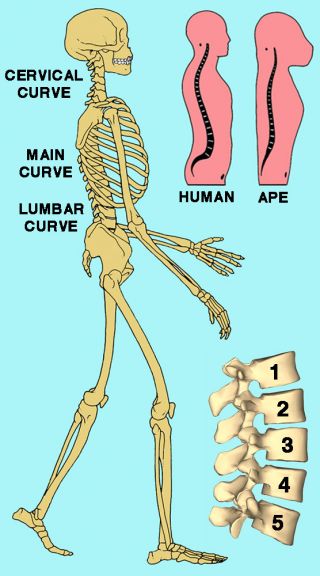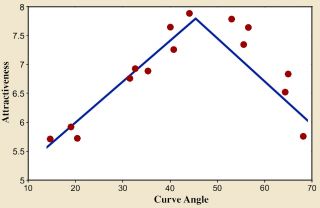Beauty
The Loveliness of Luscious Loins
New research sees sexy curves from a new angle
Posted August 11, 2015

The French, of course, have a saucy name for it: “la chute des reins”, aptly translated as “cascade of the loins”. The matter-of-fact English “small of the back” definitely lacks the Gallic flair, and the German “Kreuz” (cross) is more prosaic still. Only the French version bears expansion to express the head-turning effect of shapely loins, as in “une chute des reins à faire tourner les têtes”. Yet the attractiveness of a woman’s derrière, particularly the loins, has seldom been viewed through a scientific lens.
![//creativecommons.org/licenses/by-sa/3.0)] //creativecommons.org/licenses/by-sa/3.0)]](https://cdn.psychologytoday.com/sites/default/files/styles/article-inline-half-caption/public/field_blog_entry_images/Willendorf%20Venus%20Oblique%20Rear.jpg?itok=1x9fYDSv)
Consequences of walking upright
Emergence of upright two-legged striding, unique among mammals, was a fundamental shift in human evolution. Fossil evidence shows that definite adaptations for bipedal striding were already present four million years ago in early Australopithecus in Africa. Indeed, the skull of the oldest known hominid, Sahelanthropus — also from Africa — shows subtle indications of adaptation for upright walking some three million years earlier.
Bipedal striding is such an unusual way of getting around that its evolution entailed a whole suite of changes in the human body, literally extending from head to toe. Crucially, the legs must support the entire weight of the upper body. For stability and energy conservation the centre of gravity of the trunk must lie above the hips, so the spine (vertebral column) has been reshaped. In mammals walking on four legs, the spine typically has a primary curve bowed upwards between neck and tail. In the upright human body, this primary curve is retained but directed backwards. But two additional curves are directed forwards: a moderate cervical curve in the neck and a pronounced lumbar curve in the lower back.

As many people know to their cost, the five large lumbar vertebrae in the lower back are particularly important for bearing weight. The weight carried by individual vertebrae increases down the spine towards the pelvis, so they bear the greatest burden. This is why the pronounced forward-directed curve (lumbar lordosis) in the lower back, which stabilizes the erect trunk above the legs by aligning its centre of gravity above the hips, can give problems. The lumbar curvature is mainly attributable to the joints and discs between the vertebrae, but the lowermost vertebrae also have wedge-shaped bodies, higher at the front than at the back.

Lumbar curvature and pregnancy
Because the marked lumbar curvature in the human spine increases the potential for injury, changes in body shape during pregnancy predictably pose particular problems. During pregnancy the weight of a woman’s abdomen increases by almost a third. The additional loading lies in front of the spine, so a woman must lean backwards to keep the centre of gravity over her hips, thus further increasing the lumbar curvature. In a ground-breaking 2007 paper, Katherine Whitcome, Liza Shapiro and Daniel Lieberman showed that increased curvature and reinforcement of the lumbar vertebrae evolved in women to offset greater anterior loading during pregnancy. Longitudinal study of 19 pregnant women showed that increasing the angle between the lower back and pelvis by an average of 18o permitted them to maintain a stable location of the centre of gravity above the hips as the fetus developed. When pregnant women were prevented from exaggerating the lumbar curvature in this way, the centre of gravity was shifted forward by about one-and-a-half inches as birth approached, resulting in an eightfold increase in the torque exerted by the upper body around the hip. Although a woman can adjust the position of the centre of gravity by leaning backwards, this comes at the cost of greater shearing forces in that region of the spine.
Analyses revealed that several features of the lumbar vertebrae differ markedly between men and women. In particular, men typically have only two vertebrae — the fourth and the fifth — that are wedge-shaped, whereas the third vertebra in women also shows wedging. This benefits women during pregnancy because it enables them to increase curvature of the lower spine with less rotation between vertebrae, reducing the shear force across the joints by about 30%.
As other primates lack any sex difference in their lumbar vertebrae, the distinction between male and female skeletons evidently emerged during human evolution. In fact, Whitcome and colleagues inferred that a comparable divergence between the sexes was already present in vertebrae in putative male and female skeletons of Australopithecus. Only two fairly complete lumbar spine segments are known for australopithecines; one shows the typical human female pattern with three clearly wedged vertebrae, whereas the other has a male-like pattern with only one wedge-shaped vertebra. So it seems that an increase in female lumbar curvature to compensate for additional loading during pregnancy was present in bipedal australopithecines well before the genus Homo emerged.

Attractive lumbar curvature
The greater lumbar curvature in women was first clearly established in 1985 after orthopedists Robert Fernand and Daniel Fox examined X-rays from almost 1,000 patients. They reported a significant difference, with lumbar curvature some 14% greater in women. However, male responses to this feature in a woman’s profile remained largely unexplored, and a recent online publication by David Lewis and colleagues is the first real contribution. They conducted tests with male psychology students, who rated female profiles for academic credit. In an initial study, 100 students were asked to assess attractiveness of lateral images of women manipulated to differ only in the angle of lumbar curvature. Perceived attractiveness peaked at an angle of 45o, close to the average of 47o identified for women by Fernand and Fox. Attractiveness rating declined on either side of this value, so both weak curvature (hypolordosis) and exaggerated curvature (hyperlordosis) received low ratings. Claiming that both extremes are linked to lower back pain, Lewis and colleagues identified an angle of 45o as a theoretical optimum favoured by stabilizing selection.

But ratings of the female profiles tested are potentially problematic because lumbar curvature can be influenced by buttock volume as well as wedging of lumbar vertebrae. So Lewis and colleagues conducted a second series of tests in which 200 men had to choose the most attractive profile among alternatives that had identical buttock protrusion for three different reasons: well-developed buttock muscles, substantial buttock fat deposits, or marked lumbar curvature. Although the results were somewhat complex, overall men seemed to prefer profiles in which buttock protrusion was due to vertebral wedging, not buttock volume.
The results reported by Lewis and colleagues are intrinsically interesting in indicating that test subjects preferred female profiles with moderate lumbar curvature due to wedging of vertebrae. But their working hypothesis that “men possess evolved mate preferences for lumbar curvature in women” is questionable. The study does not actually show that an evolved response must be involved. A first step in that direction would be to demonstrate that men’s assessments of female lumbar curvature are consistent across cultures. However, the key requirement for cross-cultural study remained unmentioned.
Attractive or just average?
In fact, more fundamental problems afflict such studies of women’s attractiveness. One is a tendency to limit investigation to individual features, as with the waist-hip ratio discussed previously (Waists, Hips and the Sexy Hourglass Shape, posted July 20). Another is widespread reliance on 2-dimensional front-viewed female test profiles, although the new study of attractiveness of lumbar curvature in women is a welcome departure because lateral images were needed. Moreover, many other individual features contribute to overall attractiveness of female body shape, such as the ratio between leg and body lengths. But perhaps most problematic of all is that the average condition is often rated as most attractive, and it is unclear what this means. Yet one thing is certain. The study by Lewis and colleagues showed that those viral internet images of Kim Kardashian show a lumbar curvature rated as unattractive and lying in a range that is probably pathological.
References
Fernand, R. & Fox, D.E. (1985) Evaluation of lumbar lordosis: A prospective and retrospective study. Spine 10:799-803.
Frederick, D.A., Hadji-Michael, M., Furnham, A. & Swami, V. (2010) The influence of leg-to-body ratio (LBR) on judgments of female physical attractiveness: Assessments of computer-generated images varying in LBR. Body Image 7:51-55.
Furnham, A., Swami, V, & Shah, K. (2006) Body weight, waist-to-hip ratio and breast size correlates of ratings of attractiveness and health. Personality & Individual Differences 41:443-454.
George, S.Z., Hicks, G.E., Nevitt, M.A., Cauley, J.A. & Vogt, M.T. (2003) The relationship between lumbar lordosis and radiologic variables and lumbar lordosis and clinical variables in elderly, African-American women. Journal of Spinal Disorders and Techniques 16:200-206.
Jensen, R.K., Doucet, S. & Treitz, T. (1996) Changes in segment mass and mass distribution during pregnancy. Journal of Biomechanics 29:251-256.
Lewis, D.M.G., Russell, E.M., Al-Shawaf, L. & Buss, D.M. (2015) Lumbar curvature: a previously undiscovered standard of attractiveness. Evolution and Human Behavior (in press).
Martin, R.D. (1992). Walking on two legs. p. 78 in: The Cambridge Encyclopedia of Human Evolution (eds. Jones, J.S., Martin, R.D., Pilbeam, D.R. & Bunney, S.) Cambridge: Cambridge University Press.
Shefi, S., Soudack, M., Konen, E. & Been, E. (2013) Development of the lumbar lordotic curvature in children from age 2 to 20 years. Spine 38:E602-E608.
Tovée, M.J. & Cornelissen, P.L. (2001) Female and male perceptions of female physical attractiveness in front-view and profile. British Journal of Psychology 92:391-402.
Whitcome, K., Shapiro, L.J. & Lieberman, D.E. (2007) Fetal load and the evolution of lumbar lordosis in bipedal hominins. Nature 450:1075-1078.




